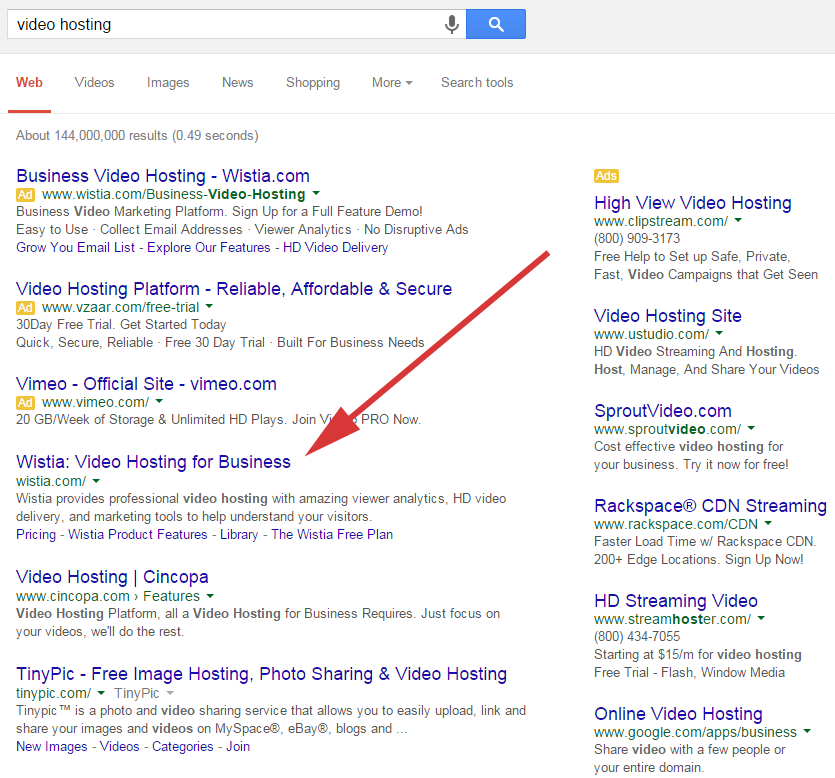How Mission Marketing Can Improve Your SEO
Note: This post was originally published in 2015.
These days, most clients and prospects I talk to believe they’ve run out of things to write about. One ceaseless option is to update (and improve upon) their existing assets and stale “evergreen” pieces. Yes—evergreen pieces do go stale. But this post is about new ideas in a modern age.
The days of “one landing page per keyword” is SEO history. The emerging best practices for SEO content—in text form—is (again) long-form, holistic copy. Searchmetrics has told us this for years. It’s not a 1:1—it’s not because Google inherently thinks long copy is better for them to serve.
The correlation is likely related to Hummingbird, Google’s improvement incomprehension, and good old fashioned keywords and synonyms. Or maybe it has to do with the content’s improved power to convert (and lower the bounce).
At the end of the day in 2014, the bigger the net you cast, the more likely to capture Google’s attention and trust. At SMX East, Search Metrics’ Marcus Tober gave a great presentation providing more context.
I don’t know about you, but I didn’t really need a study. I’ve been seeing it myself.
Post-Hummingbird, I’ve been getting more robust pieces in my searches. What I haven’t been seeing as often are the pages that had 400-word blocks, clearly cranked out with keyword saturation, stuffed at the bottom of eComm pages or brochure pages. You know the kind—quite possibly purchased content from any number of cheap, copy-turning services that hit your inbox on a daily basis (giving SEO spam a real run for its money).
While that old (and somewhat lazy) practice is still very much the go-to of many SEOs today, I believe there’s been a clear shift toward rewarding pages with perceptible meanings and relationships.
And thus, this will only fuel the SEO battle against designers’ allegations that “text is ugly!”
Writing Outside The Box
A trendy thing today is something that, while not new, is absolutely valuable for several reasons. Mission marketing is about promoting your company’s mission above, or in parallel with, other goal-oriented initiatives.
Guitar Center’s mission is very high-level: “We help people make music.” Through this mission, their goal is to sell a ton of instruments. But based around this mission, Guitar Center can write about everything from DIY home recording tips to the proper way to lower your action on an electric guitar.
All this great content can be aimed toward targets revealed by data. Google will then see the relationships in these pieces to Guitar Center’s core mission, start trusting Guitar Center above their competitors, and naturally give them a ranking edge.
As a byproduct, this retailer can now write things that are anything but salesy, which could get passed around in social channels, reinterpreted in other blogs and websites, and ideally provide citations and links.
The approach can work for any industry or vertical, and unlock topics…like a beast!
The Buffer Example
Hopefully, you know what Buffer is. From their website:
“Buffer helps you manage multiple social media accounts at once. Quickly schedule content from anywhere on the Web, collaborate with team members, and analyze rich statistics on how your posts perform.”
Sounds like your run-of-the-mill SaaS application, with niche value, routinely copied, and just kind of “meh” from a quick glance.
But Buffer (the company) is very smart. They took what could otherwise be perceived as a commonplace service and brand, and created a universe of value. They’re leaders in their space. They have people’s attention. They weren’t the first to offer this service (Ping.fm and Hootsuite jump to mind), but they’re the first to win posts like this and this, all linking to them.
They did this with mission marketing.
Buffer says their mission is to make it super easy to share great content. Certainly, their core audience are people who want to promote. For marketers and curators alike, Buffer becomes a resource center for tips and advice. It’s not a surprise when you see something from their domain rank #1 for “marketing tools.”
Now, you may look at this ranking and say, “Sure Bill, but this is ranking a blog post, and not their services page.” I hear you. But with a term like this, with all the competition, and a very low likelihood that Google is ever going to really care about pushing your “sign-up” page to number one here, would you really be disappointed if you were Buffer?
This is an amazing branding opportunity, and a chance to earn email signups, loyalty, and mindshare.
I’m a huge fan of the way they come up with topics—all things that help marketers. For example:
- https://blog.bufferapp.com/free-image-sources-list – 22,624 social shares, 24,625 links
- https://blog.bufferapp.com/the-ideal-length-of-everything-online-according-to-science 22,560 social shares, 1,742 links
The Wistia Example
Here’s another gem. There’s a giant in the video-hosting space. You may have heard of them. They’re also the second largest search engine. However, Wistia doesn’t compete with just YouTube, but Vimeo, Viddler, Brightcove, and a bunch more.
Wistia is all about mission marketing—so much so they even wrote a great post about it.
In this case, their domain power actually ranked their homepage first for the keyword “Video Hosting.” That’s an amazing win.
Selling The Concept
Big SEO companies are occasionally doing this. I’ve talked with many colleagues about the assets they’re helping to create. Sometimes, they seem very out of the left field and unrelated to the business, usually with the goal of just being amusing and attracting (albeit irrelevant) links.
But sometimes I hear about an interactive piece, pitched to a big site like Mashable or Forbes, where the asset is, at first glance, only loosely based on the services and products of the business. But pulling back the lens, you see the piece is actually in harmony with the company’s mission.
Let’s make up an example. Let’s assume you are marketing (and doing SEO) for a large-format inkjet printing company. Their claim to fame is printing archival posters for amateur and professional photographers.
In terms of boring industries, this could be up there! Let’s also assume the company doesn’t have a blog or any notable content section at all. The above examples (Wistia and Buffer) were implemented on a blog, but content can live anywhere.
Your first thought might be to begin with keyword research, getting keyword metrics, and all the typical SEO blocking and tackling you’re accustomed to. Then you might discover “archival ink” is a valuable keyword, so you begin to write a few sentences on your services page:
“Your photographs deserve a professional canvas! Our 24×36 ink jet photo prints are printed on a glossy or luster heavy stock paper with only archival ink. Our pigment-based archival ink is bright in color and will never fade when kept away from harsh daylight.
For the deepest blues, the darkest blacks, and the warmest yellow and reds, visit Handsome Bill’s Posters R’ Us Emporium to order your gallery quality poster today. Did we mention we use archival ink? Order now and receive a free VHS player (while supplies last).”
Here’s the problem. Not only will this probably not move the needle, but it won’t even begin to get you through the noise. All your competition at minimum is producing this same content. You are not standing out, and you certainly are not doing anything powerful for your brand.
So let’s consider mission marketing. As a marketer, you ask the CEO for their company’s mission. Bill—a good, altruistic man—says, “We really want to help photographers see their art presented in the best light.” Ah, now we can use this!
You return to the drawing board coming up with ideas and titles (also based on keyword data) like, “Color matching made easy—Ensuring you print what you see on your screen,” or “Popular desktop photo printers reviewed.” It turns out these are things your audience struggles with. These are things they really care about. These are things they’d be eager to bookmark, share, comment on, and visit again and again.
You passionately return to your CEO and pitch your ideas: “We could create a content center, or we could append this content to our existing category pages. We could be heroes to our customers! You should give me a promotion!” Unfortunately, you’re countered with, “How will this make us money and give away free VCRs? We don’t want customers printing at home. We want them using us!”
This is traditionally where I see mission marketing initiatives run out of gas. They get shot down without the big picture context. The response here is logic-based. This company must understand the need to cut through Internet noise thicker than the Congo.
To reach any audience today, you need to not just provide for the searchers’ requests, but beat Google’s scrutiny. Let’s also face facts—many times, your service is a dime-a-dozen. Marketing has always been the answer to standing out.
True, there may be a few sales you lose when you teach someone how to do the printing themselves, but you also stand to at minimum get in front of your target audience. You get a chance to be there when the customer says, “Meh…this home printing thing is too hard. I’m going to hire a trustworthy company of experts,” or, “This print looks amazing as an 8×10. I want to see it as a 24×36. That Bill guy had a company that did this.”
This is the bigger picture. This is less tactical, more strategic SEO for the win. This is brand building—which we all know is helpful in search results these days. This is digital marketing.
Mission Marketing and the Big Picture
I love mission marketing for all things SEO, brand building, and digital marketing. There’s no shortage of ideas when you operate on your mission. If you’re simply performing product-based marketing, and you sell what everyone else sells, you’re probably relying on luck—whether you realize it or not.
Times have changed, and simply having SEO functionality on your team isn’t an advantage anymore. You need to start working toward the bigger picture. You need comprehensive content to convince Google and users alike that you are the supreme being in your industry.









